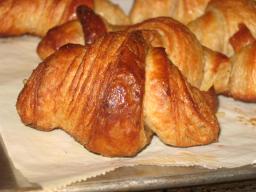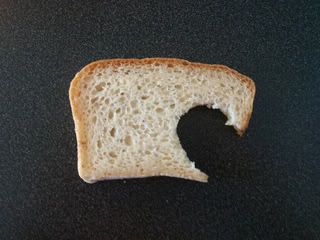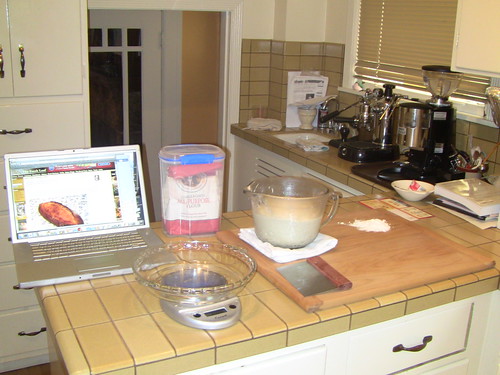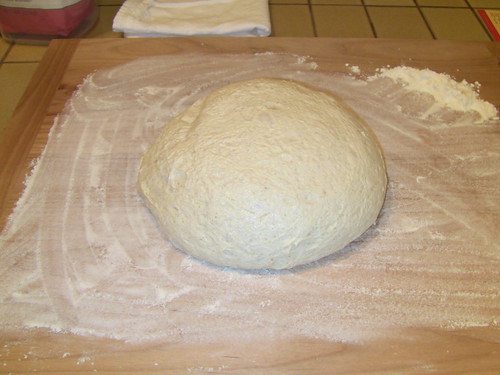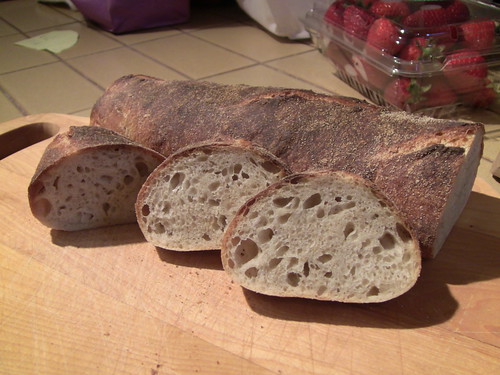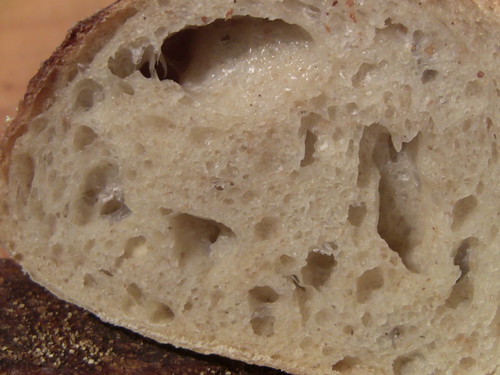Okay, after all the compliments and enthusiasm over my new WFO, it is time to tell the dirty details of something I only just touched on in my earlier blog post: the little matter of too much fire too soon, and the problems with the doorway arch.
Saturday morning I got over enthusiastic throwing wood into my "small drying fire". My wife admonished with "Isn't that a little big?", to which I replied in my best know-it-all tone "No honey, you should see a big fire!". Then we noticed the cracks, and the top bricks of the arch sagging from thieir proper position. After much running around for steel buckets, fireplace tools, water and my heavy elbow-length gauntlets (it was really hot in there) I shoveled the live fire out of the oven as fast as I could and doused it with water in the bucket. It was too late though, and the damage was done:

The crack is not all that bad, but the brick problem is another story. A couple of days earlier we had noticed these bricks had come loose. When I investigated, the mortar and the bricks had all separated from each other and the mortar was just loose slabs between the bricks. This next shot makes it easier to see both the loose mortar and the keystone brick dropping through the top of the arch as well as a head-on view of the crack.

I hoped the insulation layer would secure things together, but the heat expansion in the dome proved I was just wishful thinking. Something had gone wrong somewhere and my arch was coming apart as I stood there. You can see the tops of two bricks I wedged into the arch to hold things up while the oven cooled off and I figured out a plan.

Here you can see my solution, if you look carefully. I hope we can get a better shot of this tomorrow when the light is better, and I will edit that shot in here if we are successful. However, if you can see it, my solution was to break another rule about ovens: I installed a metal arch support in the form of a hoop shaped to fit inside my arch. I made the hoop loose fitting, and then loosely packed a wood stove door gasket made of a fireproof, non-volatile glass fiber between the hoop and the brick to take up the slack and provide compressible space between the hoop and the masonry. These materials expand at different rates and to different extents, and I have no idea if this will work or not. Since my alternative if it fails is to rebuild the arch, and my alternative if I don't try this is to rebuild the arch, this is a free chance to get lucky. As you can see in this shot above, I pulled all the old loose mortar out of all the arch joints. That's all it took too: I just grabbed it bare-fingered and pulled each wedge out in one piece.
While working on all this and running around I noticed something I now call "probable cause". Earlier, I blamed this whole incident on too much fire in a green oven, too soon. The next shot proves I could be wrong about that. It certainly was contributory, but I'm not sure it was the cause at all. I think I made a bigger strategic error earlier in the building process, in how I joined the arch and the dome. If you look carefully at this next shot, especially at the very top brick, you will see it is tilted up to the right. This brick was dead-level when I built the arch.

Here's what I did and what I think happened:
- When I mortared the arch originally I only mortared the front 75% or so of the wedge-shaped gaps. I left the rear 25% empty so I could tie in the oven dome itself. This was, I believe, the fatal flaw.
- As planned, I built the dome and filled in the rear-most 25% of these mortar wedges in the same pass as building up the dome, effectively making those parts of the arch an integral part of the new dome. I also added a layer of oven mud over the top of the back 25% of the arch as well, thoroughly integrating the arch and the dome.
- I sat back and watched it all slow-cure as I kept the dome and the dome-arch joint draped with moist towels for three or four days, and then under cover of dry towels for two or three more days, all to slow down the surface drying and let the inner clay keep up better. During this time the new dome showed some stress cracks from drying, which I worked over with the back of a spoon as much as I could to try to iron them out. Honestly, it did not help much, and my overzealous drying fire on Saturday morning brought them all back.
Now, look again at the tilt up-to-the-right of that top brick in the shot above. I believe the oven dome shrank significantly in drying, and because the doorway arch was so throughly integrated into the dome, the dome squeezed the arch in on the sides and down on the top at the back edges of the arch bricks, popping all the mortar loose and opening up bigger gaps between bricks than were there when I built the arch originally. When the arch alone was complete, the inner surface was continuous, with the inner edges of each brick neatly and firmly in contact with the edges of it's neighbors. Now it looks like carved jack-o-lantern teeth.
The fact that I built too hot and too large a fire on Saturday only brought all this to the fore sooner. I now believe I doomed this arch when I tied it so tightly to the dome of the oven. Nothing I read told me I should do this, and it also did not tell me I should not. I learned that part myself.
I installed the new metal arch support today, and also re-mortared the arch. Now I will give the fresh mortar in the arch a couple days to dry out and go back to small (yes, really small!) drying fires to slowly cure the oven dome and all, and see how it goes. When I am finally able to really heat things up I will find out if my metal arch is going to be a help or the final straw that destroys the doorway arch. Then I will know what the next chapter will be.
Thanks for listening, and stop by again. I'll continue to post my progress, positive and negative, right here.
OldWoodenSpoon


 Leek Tarte
Leek Tarte



